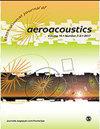Application of LES combined with a wave equation for the simulation of noise induced by a flow past a generic side mirror
IF 1.3
4区 工程技术
Q3 ACOUSTICS
引用次数: 0
Abstract
The paper presents validation results of a hybrid simulation method for aeroacoustics in turbulent flows at low Mach numbers. The hybrid method implemented in the Ansys Fluent® CFD package applies a scale-resolving turbulence model to compute the noise sources in an incompressible flow, while the noise propagation is modeled by a wave equation formulated for the acoustic potential. The selected test case deals with a flow and a sound field around a generic side view mirror of a car. The SBES model by Menter, which belongs to the class of the RANS-LES models, is used for the flow simulation. It switches to the Large Eddy Simulation (LES) mode in separated mixing layers and recirculation zone behind the mirror as well as in the following wake, where flow develops intensive turbulence and dominating noise sources. The acoustics wave equation is formulated in the model form of Kaltenbacher et al. and is applied in the time domain. The overall calculation is performed as a transient co-simulation on the same mesh using the finite-volume discretization method for both the flow and the acoustics parts. The wave equation is advanced in time using the HHT-α method. Obtained distribution of the mean wall pressure over the mirror surface closely matches the experimental one. Rich content of the resolved turbulent vortices in the separation zone and good agreement of the calculated and measured wall pressure spectra at sensor locations downstream the mirror evidence a proper LES resolution quality of noise sources. Comparison of the computed noise spectra at the remote microphones with the experimental data demonstrates the sound propagation accuracy and validates the overall aeroacoustics simulation method.应用LES结合波动方程模拟流过一般侧镜所引起的噪声
本文给出了低马赫数湍流中气动声学混合模拟方法的验证结果。Ansys Fluent®CFD软件包中实现的混合方法应用比例分辨湍流模型来计算不可压缩流中的噪声源,而噪声传播则通过为声势制定的波动方程进行建模。选定的测试用例处理汽车通用侧视镜周围的流场和声场。Menter的SBES模型属于RANS-LES模型的一类,用于流动模拟。在分离的混合层和反射镜后面的再循环区以及随后的尾流中,它切换到大涡模拟(LES)模式,在尾流中流动产生强烈的湍流和主要的噪声源。声波方程采用Kaltenbacher等人的模型形式,并在时域中应用。整体计算是在同一网格上使用流动和声学部分的有限体积离散化方法进行的瞬态联合模拟。用HHT-α方法在时间上推导出波动方程。所获得的镜面上的平均壁压分布与实验结果非常吻合。分离区中已解析的湍流涡流含量丰富,反射镜下游传感器位置处计算和测量的壁面压力谱一致,证明噪声源具有适当的LES分辨率。将远程麦克风的计算噪声谱与实验数据进行比较,验证了声音传播的准确性,并验证了整体气动声学模拟方法。
本文章由计算机程序翻译,如有差异,请以英文原文为准。
求助全文
约1分钟内获得全文
求助全文
来源期刊

International Journal of Aeroacoustics
ACOUSTICS-ENGINEERING, AEROSPACE
CiteScore
2.10
自引率
10.00%
发文量
38
审稿时长
>12 weeks
期刊介绍:
International Journal of Aeroacoustics is a peer-reviewed journal publishing developments in all areas of fundamental and applied aeroacoustics. Fundamental topics include advances in understanding aeroacoustics phenomena; applied topics include all aspects of civil and military aircraft, automobile and high speed train aeroacoustics, and the impact of acoustics on structures. As well as original contributions, state of the art reviews and surveys will be published.
Subtopics include, among others, jet mixing noise; screech tones; broadband shock associated noise and methods for suppression; the near-ground acoustic environment of Short Take-Off and Vertical Landing (STOVL) aircraft; weapons bay aeroacoustics, cavity acoustics, closed-loop feedback control of aeroacoustic phenomena; computational aeroacoustics including high fidelity numerical simulations, and analytical acoustics.
 求助内容:
求助内容: 应助结果提醒方式:
应助结果提醒方式:


